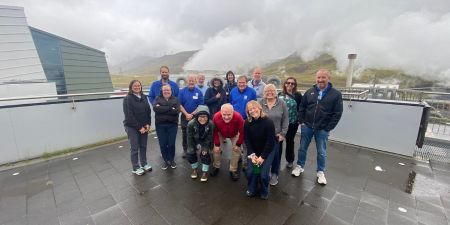
The morning of Day five the CREATE faculty return to the University of Reykjavik to continue the energy lecture series. Two experts provided insights into Iceland’s ambitious plans for sustainable urban development and energy efficiency. Asdis Kristinsdottir, a mechanical engineer from the Borgarlinan Bus Rapid Transit (BRT) program, discussed the intricate logistics of transforming Reykjavik’s transportation system. Highlighting the Reykjavik Master Plan 2040, she emphasized the goal of reducing car usage from 76% to 58%, while increasing public transport use from 5% to 12%. The plan also envisions a substantial increase in bike and pedestrian pathways, bolstered by the popularity of electric bikes. The new BRT system, designed to run at 7-10 minute intervals, aims to make public transportation a more convenient and attractive option.
Kristinsdottir pointed out the historical reliance on cars due to the extensive highway network funded by the national government. The challenge now lies in shifting public behavior towards embracing sustainable transit options. Infrastructure developments, like the Alda Bridge, exclusively for buses, bikes, and pedestrians, are steps in the right direction, but public buy-in remains a critical hurdle.
Sigurdur Fridleifsson from Orkustofnun focused on Iceland’s energy policy and the transition to electric vehicles (EVs). He detailed the many economic and environmental benefits of EVs, noting that they consume a quarter of the energy compared to internal combustion engine (ICE) vehicles. Fridleifsson highlighted the impact of Icelandic incentives, such as the elimination of VAT and import taxes, which have made EVs financially attractive.
Iceland’s abundant hydropower and geothermal resources provide a strong foundation for this energy transition, making it possible to meet the demands of electricity, space heating, and transportation sustainably. Fridleifsson also underscored the need for continued policy support to maintain the momentum towards an all-electric vehicle fleet, emphasizing the dual benefits of reduced emissions and lower transportation costs.
Together, these lectures painted a comprehensive picture of Iceland’s proactive steps towards a greener, more efficient future, leveraging both innovative transportation solutions and renewable energy resources.
After lunch the group boarded an EV bus and headed to ON Power for a site visit to a geothermal power plant and carbon capture facility. During the visit to ON Power and the Hellisheidi geothermal power plant in Iceland, the team discovered the innovative ways this facility maximizes the use of geothermal energy. Unlike many geothermal plants that solely focus on energy production, Hellisheidi collaborates with various businesses within the Geo-Park to utilize geothermal by-products, creating a synergistic ecosystem.
One standout partnership is with Climeworks, which captures CO2 directly from the atmosphere, helping ON Power achieve carbon neutrality. Vaxa, another partner, uses the abundant and nearby electricity for intensive microalgae production, which requires significant energy for running fans. Geo-silica takes waste silica to produce cosmetics, and a nearby hydrogen electrolyzer station further exemplifies the integrated approach.
The geothermal process at Hellisheidi is remarkably efficient, with a combined heat and power efficiency of 60-70%. The plant not only generates 45 MW of electricity per generator but also utilizes captured H2S and CO2, reinjecting them into the earth, transforming them into stable minerals like FeS2. This closed-loop system ensures that geothermal fluid extracted is eventually returned underground, maintaining the sustainability of the resource.
One intriguing aspect of this plant is its resilience and longevity. Icelandic plants, some dating back to the 1950s, are still operational, highlighting the durability of geothermal energy infrastructure in the region. Additionally, the geological conditions in Iceland prevent issues like subsidence and water depletion, common in other geothermal hotspots like California and New Zealand.
ON Power’s approach is not only environmentally sustainable but also economically savvy. By collaborating with various companies and leveraging the by-products of geothermal energy, Hellisheidi exemplifies how integrated resource management can lead to significant advancements in both energy production and environmental stewardship. This model showcases the potential for geothermal energy to be a cornerstone of sustainable development.
Today’s activities gave the CREATE team good insight to Icelandic Energy policy and geothermal power production, the country’s second largest energy source. Tomorrow they will visit Brimborg EV Vehicle Imports and Distribution.
Sign up for the CREATE Newsletter and stay updated on the latest information in Renewable Energy Education.
Copyright @ 2025 CREATE National Energy Center
This material is based upon work supported by the National Science Foundation under Grant #2201631. Any opinions, findings, and conclusions or recommendations expressed in this material are those of the author(s) and do not necessarily reflect the views of the National ScienceFoundation.